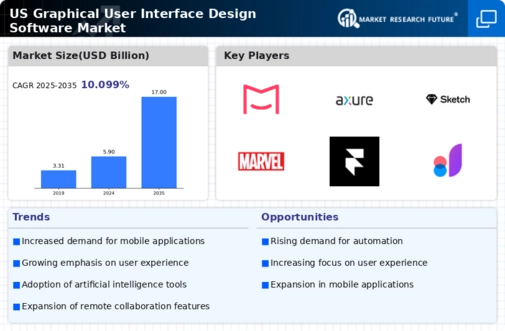Surge in Mobile Application Development
The rapid growth of mobile application development is a key driver for the graphical user-interface-design-software market. As businesses increasingly prioritize mobile platforms, the demand for intuitive and visually appealing interfaces has surged. In 2025, mobile app revenues in the US are projected to reach approximately $100 billion, indicating a robust market for design tools that cater to mobile applications. This trend necessitates software that can facilitate the creation of responsive designs, ensuring compatibility across various devices. Consequently, companies are investing in graphical user-interface-design-software to enhance user experience and engagement, thereby driving market growth.
Integration of Advanced Prototyping Tools
The integration of advanced prototyping tools within the graphical user-interface-design-software market is transforming the design process. These tools allow designers to create interactive mockups that simulate user interactions, which is crucial for user testing and feedback. As of 2025, the prototyping tools segment is expected to account for over 30% of the overall market share, reflecting a growing preference for software that streamlines the design workflow. This shift not only enhances collaboration among teams but also accelerates the product development cycle, making it essential for companies to adopt sophisticated design software to remain competitive.
Growing Emphasis on Accessibility Standards
The increasing focus on accessibility standards in software design is significantly impacting the graphical user-interface-design-software market. As organizations strive to comply with regulations such as the Americans with Disabilities Act (ADA), there is a heightened demand for design tools that facilitate the creation of accessible interfaces. In 2025, it is estimated that over 20% of the US population will have some form of disability, underscoring the necessity for inclusive design practices. This trend compels software developers to invest in graphical user-interface-design-software that incorporates features enabling compliance with accessibility guidelines, thereby expanding their market reach.
Rise of Remote Work and Digital Collaboration
The rise of remote work and digital collaboration is reshaping the landscape of the graphical user-interface-design-software market. As teams become increasingly distributed, the need for collaborative design tools that allow real-time feedback and editing has intensified. In 2025, it is anticipated that remote work will constitute over 30% of the US workforce, driving demand for software that supports seamless collaboration. This shift encourages the development of graphical user-interface-design-software that integrates cloud-based functionalities, enabling designers to work together effectively regardless of their physical location, thus fostering innovation and creativity.
Increased Investment in User Experience Research
The growing recognition of user experience (UX) as a critical component of product success is propelling the graphical user-interface-design-software market. Companies are allocating more resources to UX research, with budgets for user testing and feedback mechanisms expected to rise by 15% in 2025. This investment reflects a broader understanding that superior user interfaces can lead to higher customer satisfaction and retention rates. As a result, there is a heightened demand for graphical user-interface-design-software that incorporates user research tools, enabling designers to create interfaces that resonate with their target audience, ultimately driving market growth.























Leave a Comment